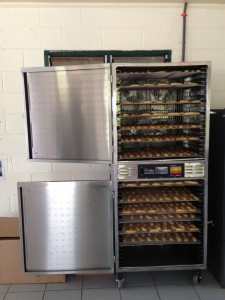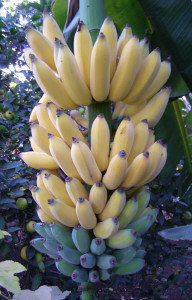 My friend and former colleague Stephen Hazelman of the Secretariat of the Pacific Community (SPC) has been telling me about his new toy, a drier that an NGO in Samoa called Women in Business Development Inc. is using to process a local banana variety for export to New Zealand. You can see it on the left, thanks to Stephen. Drying overcomes the need for quarantine treatments in NZ. They harvest from certified organic farmers, ripen the fruits for 4-7 days, peel, soak in lime juice to stop blackening, then put in the drier for 15-20 hours, cool and pack in nice yellow 50g packages for export. They are also looking at teas, cinnamon, other fruits like pineapple and mangos, and also vegetables.
My friend and former colleague Stephen Hazelman of the Secretariat of the Pacific Community (SPC) has been telling me about his new toy, a drier that an NGO in Samoa called Women in Business Development Inc. is using to process a local banana variety for export to New Zealand. You can see it on the left, thanks to Stephen. Drying overcomes the need for quarantine treatments in NZ. They harvest from certified organic farmers, ripen the fruits for 4-7 days, peel, soak in lime juice to stop blackening, then put in the drier for 15-20 hours, cool and pack in nice yellow 50g packages for export. They are also looking at teas, cinnamon, other fruits like pineapple and mangos, and also vegetables.
 The variety involved is a small, sweet, high-altitude local type called Misi Luki. You can read all about its history and characteristics, and also see some pictures here. ((Thanks to Encanto Farms for the photo.)) It’s listed in ProMusa’s checklist of banana cultivars as an AAB type. If the banana were a neglected or underutilized species (NUS), Stephen could have reported on this under the “upgrading value chains” theme of the recent conference in Accra. But of course what works for weird and wonderful local landraces of the staples could also work for NUS. No news on whether Misi Luki is on any gourmet menus. But that’s another story…
The variety involved is a small, sweet, high-altitude local type called Misi Luki. You can read all about its history and characteristics, and also see some pictures here. ((Thanks to Encanto Farms for the photo.)) It’s listed in ProMusa’s checklist of banana cultivars as an AAB type. If the banana were a neglected or underutilized species (NUS), Stephen could have reported on this under the “upgrading value chains” theme of the recent conference in Accra. But of course what works for weird and wonderful local landraces of the staples could also work for NUS. No news on whether Misi Luki is on any gourmet menus. But that’s another story…
It’s not clear to which subgroup Misi Luki belongs. Some say Mysore, others say Silk. Both are AAB subgroups that were domesticated in Asia and have since spread to other banana-producing regions, but it’s not clear whether they should be separate subgroups.
What is needed to make sense of the haphazard way banana cultivars have been classified is a committee of experts in banana taxonomy reviewing the evidence and making proposals to standardize the subgroups and identify synonyms. We hope that the checklist that you refer to, but cannot link to because it’s not yet public (your link is to the Musapedia Cultivar Diversity portal), will stimulate this kind of initiative.
To come back to the topic of your blog, the problem with exporting Misi Luki is that its skin bruises easily. While it’s true that local banana landraces are underutilized in general, it’s even truer of the bananas domesticated in the Pacific, which Misi Luki is not. The best known are the Maoli, Popoulu and Iholena bananas but the western Pacific is also host to a diversity of cultivars that have yet to be classified http://www.promusa.org/tiki-view_blog_post.php?postId=153, much less evaluated for their export potential.
You’re completely correct – banana cultivars haven’t been kept track of very well at all and there is so much conflicting information. I read somewhere that Misi Luki is an improved ladyfinger… Which doesn’t make sense, as all other info points to it being discovered, not developed (at least not in modern times).
Tissue culture (micropropagation) has almost ruined the Musa genus, as well as many other types of fruit & vege.
Somaclonal variation (mutations cause by the in-vitro processes) mutates the plants, sometimes subtly, sometimes far more obviously – but to whatever visable level the mutations occur, the tissue cultured plants are not the same as they are when they are propagated by suckers or when using other methods of macropropagation. And the tissue culture plants have been spread far and wide. Many farms have had their plants replaced with tissue cultured plants.
Many, many varieties of banana are the results of selections made from tissue culture mutants. “Embryo rescue” is another biotech method used in banana breeding (& plant breeding in general).
There is also a risk of contamination by foreign genes during the tissue culture process…making the resulting plants GMO’s.
So really, if you want real natural bananas derived only from naturally occurring mutations (triploids etc), then starting from scratch would be a good idea! Wild diploids like M. acuminata, M. balbisiana and others such as M. itinerans etc could be bred and triploids selected. And maybe landrace triploids such as Misi Luki, could be breed with wild, or hybrid diploids, in the hopes of getting triploids.
The chances of getting triploid seeds and getting them to sprout are small…some old literature suggest around 3 in every 1000. But it would be well worth it in my opinion and could save natural bananas from being completely replaced by synthetic creations.
I will give it a go.